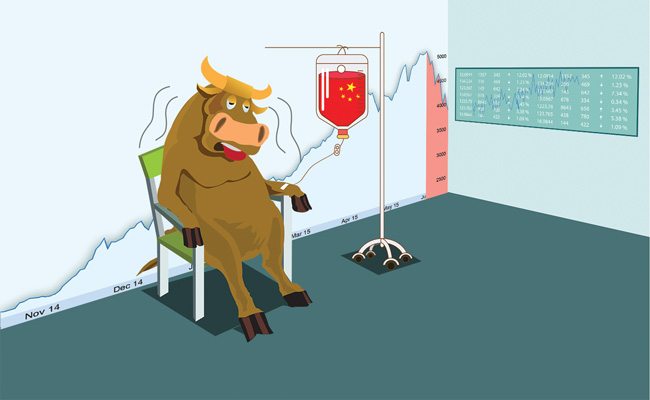Why the government’s efforts to stabilize China’s flailing stock markets have not worked well so far.
Just when people thought that the government’s efforts to rescue the China stock markets were working, shares in Shanghai fell again. The Shanghai Composite Index opened 3.21% lower on Tuesday and never gained a single point during the day. And by the time the market closed, the index lost 1.29%. So why has the rescue not worked as well as many expected? Should Beijing do more to reverse the market loss?
Stabilizing the Market
Among the new measures Beijing has been experimenting with in recent days, the most effective one is believed to be the setting-up of a “buffer fund” at China Securities Finance Corporation (CSF), which could directly participate in buying stocks to stabilize share prices. On the other hand, CSF is China’s only institution that provides margin financing loan services to securities firms—which means that it can also provide leverage support for securities firms.
But for now, details on how this arrangement would work are still lacking; on Sunday, the People’s Bank of China (PBOC) released a statement saying that the central bank would provide “liquidity support” to CSF to enhance its market stabilization capabilities, without specifying the scale or financing channels.
On Saturday, 21 securities firms, after being summoned by the China Securities Regulatory Commission (CSRC) for an emergency meeting, issued a joint statement that together they would invest at least RMB 120 billion in blue-chip exchange traded funds (ETFs) to “firmly maintain the stable development of the stock market”. But again, there are few details on how and when the injection will be made. Analysts say that the firms could either pool their funds at CSF or invest individually.
PBOC’s stance is not to provide unlimited liquidity to the CSF but to provide support to the RMB 120 billion injection by securities firms, wrote Hong Hao, Chief Strategist at Bank of Communications International, in his blog yesterday. Hong believes that the government’s rescue measures are meant to avoid systematic risks in China’s financial markets, rather than to stimulate rapid growth.
Therefore, even if the so-called “national team” does go all in, they are most likely to buy into shares of large-cap stocks, notably those of big state-owned enterprises listed in Shanghai, according to analysts. For example, the 2.41% rebound of the Shanghai Composite Index on Monday was led by only a quarter of stocks, while prices of the vast majority of stocks declined. Prices on the Shenzhen Stock Exchange, where most small-cap companies list, went down by 2.7% instead. The Shenzhen Composite Index took another deep dive (5.34%) on Tuesday, losing almost 40% since mid-June.
#China‘s stock market is falling faster than traders can unwind margin bets http://t.co/OaoaNijhIy pic.twitter.com/OGB48sreoC
— Pedro da Costa (@pdacosta) July 6, 2015
Lost Confidence
Since the government rescue focuses on big-cap shares, critics say that it won’t help in restoring confidence in investors who built their positions in small-cap, high-growth stocks. By Tuesday, more than 760 companies, or about 27% of all public companies in Shanghai and Shenzhen, suspended trading partly due to free falling stock prices.
The argument has its own merits, but it’s unlikely that Beijing will shore up overvalued stocks just to recoup losses for individual investors. “A large number of tax payers are not investing in the stock market, and it’s not fair if they have to [bear the] burden [of] the loss when the market falls,” wrote Ou-yang Hui, Professor of Finance at Cheung Kong Graduate School of Business (CKGSB) in his article in Phoenix News.
According to Ou-yang’s research, even after the recent market crash, the price-to-earnings ratios of stocks with less than RMB 30 billion market cap were still comparable to the level for similar-sized companies on October 16, 2007, the height of a stock bubble. “If [the government] buys into these small-cap stocks, there’s no guarantee that the funds won’t suffer losses.”
Therefore, the question that remains now is whether a “slow bull” is still possible once retail investors have lost their confidence in the market?
“It’s nearly impossible to manually create a slow bull,” said Liu Jing, Professor of Accounting and Finance at CKGSB. Liu says that a slow bull market is only possible when investors’ expectations change slowly. So when a strong-handed regulator tries to manually influence people’s expectations with policy changes, the market’s volatility will inevitably increase.
And for investors, it’s very risky if their expectations are only based on policy changes. For example, it was widely reported by financial media (both local and international) over the weekend that CSRC had set a target of 4,500 for the Shanghai Composite Index, but new reports on Tuesday refuted earlier stories, quoting stock brokers saying that the level was only a support level that they believed in, not a policy guidance.
“A more effective way [to rescue the market] is for regulators to establish a very clear bottom line, not a target line, for the index, ” Liu said. “And once the market stabilizes, it should be left alone to discover its own value.”




















